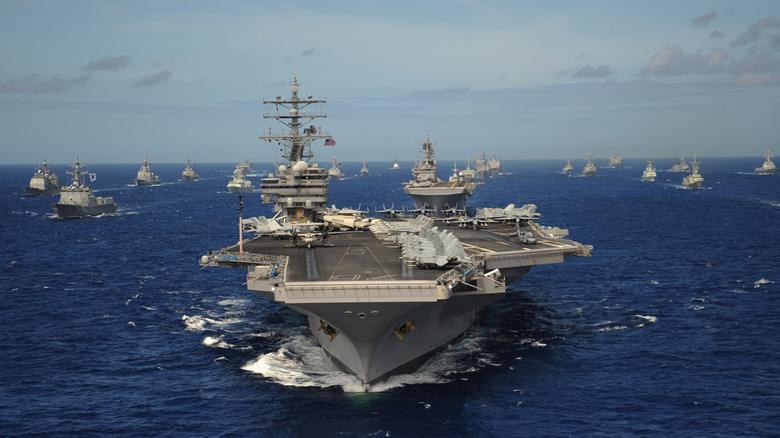What Does It Mean When A Ship Is 'Stricken' By The US Navy?
You can say a lot about the United States military, but it's nothing if not meticulous. It keeps a detailed inventory of every piece of equipment in its service, including all its vehicles from tanks to fighter jets. The U.S. Navy has a list of all active vessels called the Naval Vessel Register, where it lists the name and hull designation of every different type of aircraft carrier, destroyer, and frigate.
Whenever a new ship is commissioned and enters service, it's added to the register. For example, the registry will list the USS Enterprise, America's first nuclear-powered carrier, with its hull designation of CVN-65. Along with the name and hull designation, the registry also keeps track of the ship's fleet assignment, home port, age, planning yard, hull and machinery characteristics, battle forces, and key construction dates.
In the same respect, whenever a ship is decommissioned for one reason or another — retired, sold, or destroyed — it is stricken from the Naval Vessel Register. In other words, it's removed. We all know about the more prolific commissioned ships like the aircraft carriers (USS Nimitz, Gerald R. Ford, and Enterprise) and even the deadliest attack submarines, but they're not the only vessels struck from the registry. There's also service craft or non-commissioned vessels with a USNS hull designation. They support combat units as well as shore operations and are typically manned by civilians. This can be anything from a crane to a berthing barge.
Naval Vessel Register history
The Naval Vessel Register isn't as old as the Navy. It has only been around since the 1950s in its current form, but a rough iteration has existed in one form or another shortly after the U.S. Navy's inception. Throughout the 1800s, there were multiple publications that tracked the name and designations of naval vessels. It wasn't until 1911 that all these publications were compiled into a single list known as the Ships Data U.S. Naval Vessels by the Bureau of Construction and Repair. The Navy found this satisfactory for the next 30 years until the Bureau of Ordnance created what was known as the Vessel Register, an early iteration of the Naval Vessel Register.
In the 1960s, the NAVSEA Shipbuilding Support Office was put in charge of the registry, updating it whenever necessary. Most ships and service craft that were disposed of before 1987 haven't been added to the Naval Vessel Register yet, but as the NAVSEA Shipbuilding Support Office adds more data, it includes some of those vessels, as well, in order to keep an accurate record of its past and present inventory.
The naval vessel's life cycle
After a shipping company completes construction on a naval vessel, it will be tested for its seaworthiness in what's called a shakedown cruise. If the test is successful, the Navy holds a commission ceremony for the vessel where the commissioning pennant is broken to signify its induction into active service for the U.S. Navy, a tradition that's nearly 300 years old. The vessel will remain in service for several decades, performing its intended missions. When it has run its course and it's time for the ship to retire or if it's destroyed, it undergoes the decommission process. This can be a lengthy process and not every vessel meets the same end. Some ships remain inactive for years before it's salvaged or destroyed.
The Naval Sea Systems Command's Inactive Ships Office oversees the decommission process of all conventionally-powered vessels. When a ship is decommissioned, its name will be struck from the Naval Vessel Register, allowing the Navy to reuse it on a future vessel. Its hull designation , on the other hand, will never be reused. Once decommission has begun, the ship will have its "cool down" period where it sails to a naval facility to strip for any parts such as weapons, ammunition, and supplies to be removed. The crew will be reassigned, as well.
Some ships will be sold to private companies that will scrap them for parts while other vessels are sunk and turned into an artificial reef, such as the aircraft carrier CV/CVA-34 USS Oriskany.


